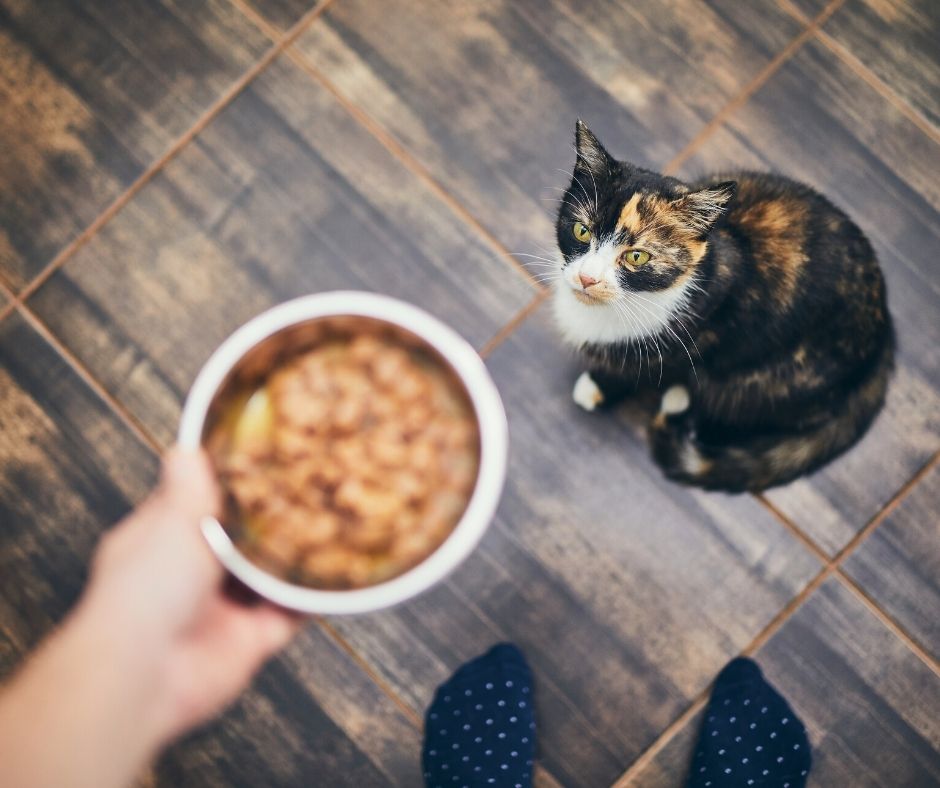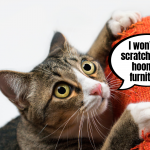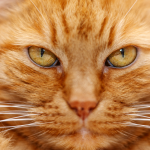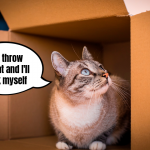Some time ago we wrote about how to help a cat to lose its weight (you can read the text here). However, what if your furry seems completely uninterested in food, regardless of the type of served treats? We know that fussy-eaters are a problem for many cat caretakers, so we decided to make a guide, but this time, with your invaluable help.
So, what you should do to encourage your pet to eat?
Why cat doesn’t want eat
Before we talk about ways to encourage a cat to eat, it’s worth considering the reasons why the animal may not want to eat in a few words. It could be many reasons – from health problems (lack of appetite may indicate such diseases as worms, kidney failure, gastrointestinal obstruction, diabetes, heart disease and even gingivitis), to more prosaic reasons, such as too high temperature in hot summer or just getting bored with one taste of the same food or its inadequate consistency. While in the case of health problems a specialist’s help will be necessary, if your cat whims over a bowl for other reasons, you can try to face it in many ways.
Hooman, it smells like litter!
As same as humans, cats won’t eat just about anything. Do you have a cat who thumb its nose when sees the contents of its bowl? If it happens, think about changing cat’s food. Your furry won’t always like the taste and smell of ready food. We tested the products of many brands ourselves, before we found perfect products for our boys, and we’re pretty sure, this love won’t last forever. If what the cat liked yesterday, today meets his despised indifference, try to change the food to one that again causes a sweet murmur of furry over the bowl again. If you have the impression that your cat has already tried everything what’s possible to buy and still been fussy – try to heat the food – the smell that will come out of the pot under the influence of temperature can make the furry change its mind. You can also add a bit of warm water to wet food to up its smell – after all, a cat’s nose is a perfect tool that will catch everything
fabCat’s tip:
Here, there is an interesting aspect of the smell of the packaging – sometimes really good food may not be recognized by the cat because of the smell – and it’s not about the composition, but about the smell of the packaging itself. Canned fragrant food can discourage a cat from eating – if you see this possibility, test if the same problem occurs when you feed the cat, e.g. with sachets.
Well seasoned = eated
The cat doesn’t want to eat? The reasons can be different – sometimes just like people, a cat may simply not like something. In this situation, it’s worth testing all sorts of natural “upgrades” that can convince the cat to dive into the bowl. Use “sprinkles” for the main course in the form of crushed, dry food, brewer’s yeast, spirulina or, for example, dried meat (e.g. dried beef, chicken or salmon) – there’ a chance that furry seeing such a bonus in the bowl will eat everything. Of course, we have more additives to choose from – pastes and sauces, to soups, raw yolks and even water, when the cat prefers wet food. Preparations that increase appetite will also help – but before you give it to a cat, consult a diet specialist.
Important:
Don’t add to the cat’s dish products like milk, dairy products, vegetable oils, smoked fish, smoked meats and canned fish for people.
fabCat’s tip:
Test also other additives, e.g. fish oil with Omega-3 acid, which will not only “turn up” the taste of the meal and cat’s appetite, but will also affect the health of furry (in this case it will manifest itself in shiny fur). Many thanks for this hint, Kamila Brodziak! Other fats also have a chance to pass the exam – try adding a bit of goose lard or clarified butter to your dinner, which will add more flavor to your standard cat meal.
Mix of flavours
Sprinkles and toppings are one method. If you have already tried and it didn’t pass the exam, try to mix two types of cat food – domestic with complementary (e.g. fillet). For example – fillet food (which is usually not the main meal of a cat) is mixed with wet domestic (at the beginning adding a teaspoon or two of fillet’s and gradually increasing the dose). Adding domestic food to fillet food raises the nutritional value of a meal (it contains the necessary ingredients and vitamins, which is most often lacking in fillet food).
A cat can also lose his appetite when you change his feed into a new one and the animal gets used to the previous one. In this case, the method of gradual mixing of both types of food should worked again, which will protect cat from shock, resulting from the change and help him adapt more easily to the new quality that awaits him in the bowl.
Right consistency
As mentioned above, some cats are more likely to eat liquid than dry meals. It is worth trying out the method for “changing the consistency” of a meal and, for example, mixing food with water or homemade meat broth (without spices and vegetables). So prepared “soup” or mousse, add, for example to the fillet food – it may turn out that the same meal, in the form of a sauce or soup, will sufficiently encourage our furry to lick the whole bowl. To encourage your cat to eat, you can also try to mix wet food with pork gelatin jelly or ready-made soups that you will find on shelves with cat food.
I will eat, but not in this!
Sometimes cat enjoy of what we have prepared for him in a bowl, but the dish itself can be a problem. Make sure that the bowl or plate on which you serve the meal is large enough so that whiskers don’t disturb the cat while eating. The size of the bowl will also matter when more than one cat eats from one dish. When we feed Kitku Yoda and Teddy with raw meat, the boys get a meal on a really big plate, so that both of them have comfort while eating and don’t have to fight for a space. If the cat doesn’t want to eat – look at it closely, because such behavior may be related to the territorial aspect and the cat’s “rule of the strongest”. When one cat is dominant, we can observe stealing snacks from another bowl, or eating greedily while the other cat is not looking. In this situation, it is worth again to take care of the right place (e.g. moving the bowl, fr away from the bowl of a stronger companion, where the weaker cat will have the conditions to eat a meal in peace).
Clean the bowl after every meal
It’s quite obvious, but still worth remembering that each time washing a bowl after a meal of the furry isn’t only a matter of hygiene – an important aspect here is also the smell (we are mainly talking here about wet meals). What’s left in the dish after an earlier meal can change the smell and taste of the meal that was just given to the cat and affect its reluctance to eating, if the mix of aromas isn’t particularly liked by the cat. In addition, the remains of previous food simply smell bad and instinct will tell cat to stay away from such a bowl. Washing the bowl also applies to the one in which there is water – there may also be “smell” residues after the last dinner.
Leave me alone, I’m eating!
Even the best treats may not be a temptation, if the bowl is standing in a spot, where the cat will not be convinced. When setting up a dish with food, make sure that it’s not a line of communication and there are no additional stimuli that would distract the furry while eating. Choose a place where the cat likes to stay and where he will have peace during the meal. Take care of peace at home during eating – put off vacuuming or other activities that cause noise that may disturb the animal while having a lunch.
Everyday, same time
Cats get used to time of serving meals, so make sure you feed your pets at similar time, every day. Here again we can share our practice – Teddy and Kitku Yoda get wet food twice a day (morning and evening), and during the day sometimes we give them some dry food (only as a snack). Thanks to this frequency, our cats can’t wait for food, they aren’t overfed and eagerly eat main dishes that we serve them twice a day. But, frankly speaking, we are juggling with new cans of karma like in a circus and we are still looking for our holy grail among cat food.
I don’t wanna eat dinner, I already ate the fur
Sometimes temporary reluctance to eat is caused by hair balls (so-called pilobezoars), which are deposited in the animal’s digestive system, causing him constipation and bloating. This problem particularly applies to long-haired cats. Special pastes, paraffin oil or cat’s grass help in this situation, thanks to which the cat can cleanse the body and regain its previous appetite.
I want drink, not eat
Cats, like humans, can show less appetite on hot summer days, so if during this period you see less interest in delicacies in your cat, there’s no reason to worry. To get your cat to eat on warmer days, try serving its meals with a higher water content, and on the early morning or late evening, when it’s cooler and the cat’s appetite isn’t suppressed by the high temperature.
Say goodbye to the fridge (only for one day!)
Sounds terrible? Well, sometimes it’s the last resort when nothing works anymore – tasty toppings, a change of food or extra stroking as a reward for a cleaned bowl. Stopping cat from eating for one day will not be dangerous for your fluffy friend, but the feeling of “lack of food” and the effect of “empty bowl” can a strong signal to eat. Remember, however, that during such a one-day fasting, the cat should have constant access to water – water have to be available to the cat all time.
How many cats (and fabCats!), so many ways to motive cat to eat. Some methods will work on the first try, others will certainly be completely wrong, because every cat is different. If you think you’ve tried everything and the cat still doesn’t eat, use the methods we’ve collected in this article and let us know if they worked. Just remember – everything within reason!
Or maybe we have forgotten something and would you add something else? Let us know in the comments!





